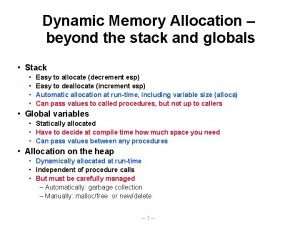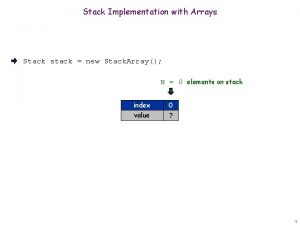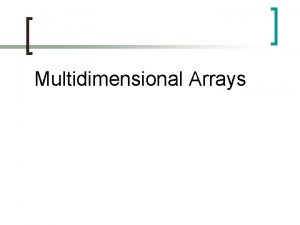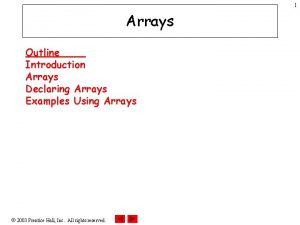Multidimensional Arrays Stack and Heap Declaring a multidimensional

![Declaring a multidimensional array on the stack: int arr[4][3] = {{3, 2, 4}, {4, Declaring a multidimensional array on the stack: int arr[4][3] = {{3, 2, 4}, {4,](https://slidetodoc.com/presentation_image_h2/1429c111d01c8f7e0e352241001d8ae3/image-2.jpg)




- Slides: 6

Multidimensional Arrays Stack and Heap
![Declaring a multidimensional array on the stack int arr43 3 2 4 4 Declaring a multidimensional array on the stack: int arr[4][3] = {{3, 2, 4}, {4,](https://slidetodoc.com/presentation_image_h2/1429c111d01c8f7e0e352241001d8ae3/image-2.jpg)
Declaring a multidimensional array on the stack: int arr[4][3] = {{3, 2, 4}, {4, 7, 1}, {2, 9, 8}, {9, 8, 7}}; Multidimensional arrays (on stack): Passing 2 -D array on the stack into a function: Function call: func 0(4, 3, arr); //for function call Function Declaration/definition: Just annoying in c++! 2 ways: • Easiest: void func 0(int x, int y, int arr[][3]) // yep, you have to specify the dimensions • Harder: convert the 2 -dimensional array to a 1 -dimensional array OR…THE HEAP…

Mulidimensional arrays on heap! int **x = NULL; // Pointer initialized with null x = new int *[4]; // Allocate memory on heap for an array of 4 addresses for (int i = 0; i < 4; i++) { x[i] = new int[3]; //making arrays for 3 ints on the heap } //for array of addresses X 0 1 2 3 2 3 4 5 In English: X is a pointer to a pointer. . . X holds the address of a space in memory that holds an address Since array variables are really just the address of the first data in a sequence of data in memory, we want to create an array of addresses! Since it’s an array of addresses, we only need the address of the first address And since we want the array of addresses to continue to exist, we want that array on the heap! So we need a pointer to the first address in that array of addresses. Hence the pointer to a pointer Or an address of the first address in an array of addresses (I don’t know why you’d find that confusing – it’s obvious!)

Mulidimensional arrays on heap? 1. int **x = NULL; 2. x = new int *[4]; // Pointer initialized with null // Allocate memory on heap for an array of 4 addresses 3. for (int i = 0; i < 4; i++) { x[i] = new int[3]; //making arrays of length 3 on the heap X 4. } //for array of addresses 0 1 2 3 2 3 4 5 More English: Once you’ve created an array of addresses on the heap (line 2), you then need to create every single array of ints on the heap (line 3 -4) Line 2 makes an array where the addresses of first values of future arrays can go Lines 3 -4 (and line 3. 5 especially) create 4 arrays on the heap of length 3, and each new returns the address of the first value of each of those arrays. That value gets stored in the array of addresses

Multidimensional arrays on heap? int **x = NULL; // Pointer initialized with null x = new int *[4]; // Allocate memory on heap for a 4 x 3 array for (int i = 0; i < 4; i++) { x[i] = new int[3]; } //for To use: for (int i = 0; i < 4; i++) { for (int j = 0; j < 3; j++) { x[i][j] = i+j; } //for for (int i = 0; i < 4; i++) { for (int j = 0; j < 3; j++) { cout << x[i][j]; } //for cout << endl; } //for Array variables ARE ALWAYS the address of the first value of the array! So whether it’s on the stack or the heap, you access the values at the indices using [] e. g. , x[i][j]

Take-aways: • Multidimensional arrays on the heap: (Aka dynamically allocated arrays): • Have to create an array of addresses (for the second set of arrays) on the heap first! • And then have to create each of the second set of arrays on the heap • Then use like any other multidimensional array • arr[x][y]


![Stack=[] digunakan untuk memebuat stack dengan …. Stack=[] digunakan untuk memebuat stack dengan ….](https://slidetodoc.com/wp-content/uploads/2020/10/1003988_042512bb86e3aab910dfb86ac5697e60-300x212.jpg)








